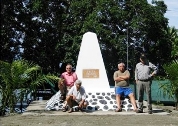 18 November 2004 to commemorate the first DETA-men who arrived on New Guinea soil 55 years ago. The memorial was created by former DETA-men Daan Sahetapy, Nico van Balgooij and Ruud Tomasow.
18 November 2004 to commemorate the first DETA-men who arrived on New Guinea soil 55 years ago. The memorial was created by former DETA-men Daan Sahetapy, Nico van Balgooij and Ruud Tomasow.Just before the transfer of the Dutch East on 27 December 1949, the Dutch Government engaged more than a 1000 young men of Dutch-Indonesian heritage.
These Indo-Europeans were hired for a one-year contract to work for DETA (Economical and Technical Service Team) to help rebuild Dutch New Guinea after the war (now Papua Province, Indonesia). There was still quite a lot to clean up after the war and New Guinea needed more infra- structure to cope with the many newcomers that were arriving. When the DETA contract expired, the men were allowed to settle permanently in New Guinea. A number of them started to work for the government or got jobs in the private business sector. Others set up their own business. The future in New Guinea, for those who dreamed of a new ‘East Indies home base’, seemed to be promising. However, they were ultimately disappointed.
Content:
1. Indo-Europeans caught between the devil and the deep blue sea
2. US army equipment left behind
3. Jayapura took on 16 groups of DETA-boys
4. A salary of 1.50 guilder a day
5. Housing the DETA-workers
6. Relaxation and entertainment
7. DETA-workers on Biak Island
8. DETA-men to find their own way
9. Links
10. Sources
1. Indo-Europeans caught between the devil and the deep blue sea
The period after the Japanese capitulation on 15 August 1945 and the proclamation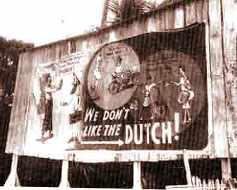 of an independent Republic of Indonesia on 17 August 1949, was a turbulent one. The Indo-Europeans were often in mortal danger during the so called Bersiap time, the vacuum without law and order immediately after capitulation, and the time of the political action of those who wanted independence. With decolonization in full flight, they were caught between two worlds, culturally and emotionally. Many, born and bred within the Indo- European community, did not know whose side they should be on. They had Dutch nationality and they would seem to belong to the privileged ‘upper crust’ but their tinted skin colour often meant they were not totally accepted by either side. In reality, they had the lower administrative positions and socially they did not really belong to the European elite. These Indo-Europeans tended to look up to the Dutch because of their white skin colour and social position, but at the same time they considered themselves to be superior to indigenous Indonesians. Yet, they had close ties with the archipelago where they were raised, rather than with the Netherlands on the other side of the globe.
of an independent Republic of Indonesia on 17 August 1949, was a turbulent one. The Indo-Europeans were often in mortal danger during the so called Bersiap time, the vacuum without law and order immediately after capitulation, and the time of the political action of those who wanted independence. With decolonization in full flight, they were caught between two worlds, culturally and emotionally. Many, born and bred within the Indo- European community, did not know whose side they should be on. They had Dutch nationality and they would seem to belong to the privileged ‘upper crust’ but their tinted skin colour often meant they were not totally accepted by either side. In reality, they had the lower administrative positions and socially they did not really belong to the European elite. These Indo-Europeans tended to look up to the Dutch because of their white skin colour and social position, but at the same time they considered themselves to be superior to indigenous Indonesians. Yet, they had close ties with the archipelago where they were raised, rather than with the Netherlands on the other side of the globe.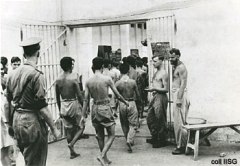 The Dutch Government therefore tried to convince the Indo-European Community to choose for Warga Negara Indonesia (WNI), that is: Indonesian citizenship. This was to prevent them from emigration en masse to the Netherlands, which would lead to economic costs and problems with adapting socially to the new adat. Also, the permanent presence of the Indo-European community would enhance a Dutch cultural element within a new independent Indonesia. After 1949, it would allow the Dutch colonial tie to be ever present and developing. However, for the Indo-Europeans themselves, there was a real urge to leave Indonesia. The fear for another Bersiap, after handing over sovereignty on 17 August 1949, was enormous. In the aftermath of the handover, there were public lectures organized by various Indo-European organisations, about opening up and developing the new frontier of former Dutch New Guinea and it becoming their new home land. With complicity of the Dutch Government, active propaganda was being pursued for the Indo-European group, who wanted a way out, to emigrate to New Guinea. After the lectures, young men were approached to take on a one-year contract to help build up the infrastructure in New Guinea.
The Dutch Government therefore tried to convince the Indo-European Community to choose for Warga Negara Indonesia (WNI), that is: Indonesian citizenship. This was to prevent them from emigration en masse to the Netherlands, which would lead to economic costs and problems with adapting socially to the new adat. Also, the permanent presence of the Indo-European community would enhance a Dutch cultural element within a new independent Indonesia. After 1949, it would allow the Dutch colonial tie to be ever present and developing. However, for the Indo-Europeans themselves, there was a real urge to leave Indonesia. The fear for another Bersiap, after handing over sovereignty on 17 August 1949, was enormous. In the aftermath of the handover, there were public lectures organized by various Indo-European organisations, about opening up and developing the new frontier of former Dutch New Guinea and it becoming their new home land. With complicity of the Dutch Government, active propaganda was being pursued for the Indo-European group, who wanted a way out, to emigrate to New Guinea. After the lectures, young men were approached to take on a one-year contract to help build up the infrastructure in New Guinea.
2. Massive US Army resources left behind
When the American army departed from New Guinea, an enormous amount of army equipment and goods were left behind. The Dutch government bought all of it for the sum of 1.000.000 guilders. As a result the enormous warehouses, which had been under the direction of thousands of Americans, were now being managed by just dozens of Dutchmen. In addition, materials left behind by the Japanese, spread across several locations, were being transported to Holland and stored there for re-use in other places in the Archipelago. In order to make an inventory of, put the material in storage and get it ready for distribution, the government set up the Dutch East Indies Management Organization that was to work under the direction of the Department of Transport in Batavia. Most of the resources were to be shipped to Batavia and Makassar to be used for the rebuilding the Dutch East Indies. In March 1946, this activity commenced with some 2000 Japanese prisoners of war as labourers under the supervision of 200 technical staff ( Dutch and Indo-European). In June of that same year,1400 of the prisoners returned to Japan and were replaced by 800 Makassar men, who had been contracted to continue the work. But this was not to last for long either, as all the Japanese and the Makassar men had to leave by the end of 1946. As the indigenous Papuan population did not have the technical know-how, the administration in Hollandia was left without a labour force to call on. To find a more permanent solution for this lack of manpower, the management was taken over by an engineering firm, Ingenegeren-Vrijburg NV, from 1 January 1947. This firm contracted labourers from Timor and Tanimbar (Moluccas). In addition, extra manpower was supplied by the collaborators sent in from Holland (men who had served with NSB groups, the German Home Guard, Waffen-SS and Wehrmacht in WWII) to do penance for being on the German side.
equipment and goods were left behind. The Dutch government bought all of it for the sum of 1.000.000 guilders. As a result the enormous warehouses, which had been under the direction of thousands of Americans, were now being managed by just dozens of Dutchmen. In addition, materials left behind by the Japanese, spread across several locations, were being transported to Holland and stored there for re-use in other places in the Archipelago. In order to make an inventory of, put the material in storage and get it ready for distribution, the government set up the Dutch East Indies Management Organization that was to work under the direction of the Department of Transport in Batavia. Most of the resources were to be shipped to Batavia and Makassar to be used for the rebuilding the Dutch East Indies. In March 1946, this activity commenced with some 2000 Japanese prisoners of war as labourers under the supervision of 200 technical staff ( Dutch and Indo-European). In June of that same year,1400 of the prisoners returned to Japan and were replaced by 800 Makassar men, who had been contracted to continue the work. But this was not to last for long either, as all the Japanese and the Makassar men had to leave by the end of 1946. As the indigenous Papuan population did not have the technical know-how, the administration in Hollandia was left without a labour force to call on. To find a more permanent solution for this lack of manpower, the management was taken over by an engineering firm, Ingenegeren-Vrijburg NV, from 1 January 1947. This firm contracted labourers from Timor and Tanimbar (Moluccas). In addition, extra manpower was supplied by the collaborators sent in from Holland (men who had served with NSB groups, the German Home Guard, Waffen-SS and Wehrmacht in WWII) to do penance for being on the German side.
3. Jayapura took on 16 groups of DETA-boys
After Indonesia became independent on 27 December 1949, New Guinea was once 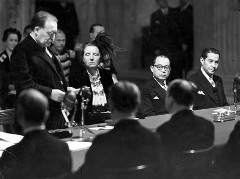 again without a ready supply of labour. The men from Timor and Tanimbar had returned home. As a result, the liquidation of former American army bases had come to a halt. The rebuilding of Hollandia, the seat of government, could not be continued. This was quite an issue because a stream of newcomers was due to arrive from both the Netherlands and Indonesia, the latter being mostly Indo-European government officials and their families. The Construction Directorate Hollandia had to work out what was to be done. Mr Wellburg, the director of this government body, had been personally assured that young Indo-European men were being recruited to work on the development of Dutch New Guinea. A few months before the handover, the DETA company had been set up specially with this purpose in mind.
again without a ready supply of labour. The men from Timor and Tanimbar had returned home. As a result, the liquidation of former American army bases had come to a halt. The rebuilding of Hollandia, the seat of government, could not be continued. This was quite an issue because a stream of newcomers was due to arrive from both the Netherlands and Indonesia, the latter being mostly Indo-European government officials and their families. The Construction Directorate Hollandia had to work out what was to be done. Mr Wellburg, the director of this government body, had been personally assured that young Indo-European men were being recruited to work on the development of Dutch New Guinea. A few months before the handover, the DETA company had been set up specially with this purpose in mind.
Between 1 December 1949 and 3 October 1950, 16 groups of contract workers came across to improve the infra- structure of a largely underdeveloped Dutch New Guinea. They had to construct roads and bridges; water, electricity and telephone networks; build houses, offices and warehouses, as well as docks and harbours. Of the 1000 men recruited, around 700 worked for DETA and the other 300 were employed by the engineering section of the Military. The young men in their early twenties were largely bachelors but in New Guinea there was a definite shortage of marriageable partners. This led to social tension and in 1952 the government allowed about 30 Indo-European women living in Indonesia to come over to New Guinea. Among them were 20 nurses who were appointed in the larger settlements. Many of them were also about 20 years old and did actually marry DETA-boys.
4. A salary of 1.50 guilders a day
In total, 1012 Indo-European men were contracted for the work to be done in New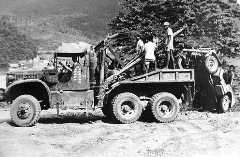 Guinea. The contract was signed by Mr R.O. Rijke, a representative of the Dutch Government stationed in Djakarta. In addition, Dutch administrators had been appointed in Semarang, Soerabajaand Makassar in order to recruit suitable labour. The news spread like wild fire among the Indo-European Community and several hundred men signed up. The contract offered a daily pay of 1.50 guilders. It paid for the journey across and included food and accommodation in New Guinea itself. One of the DETA-employees made the following observation; “Even if they had only offered 50 cents a day, they would still have found sufficient men to go. We were in quite a fix ”. Whatever their motivation to come, they had one thing in common: An urge for freedom and adventure. They were looking for a suitable and safe environment where they could settle to build up a future. However, the Dutch administration in New Guinea created an atmosphere of distrust and kept the DETA-boys at a distance. Most of these men grew up in circumstances created by war and they were free-spirited individuals. Despite being unskilled workers, who had to do the dirty work, they did expect to be treated with respect. But this was often not the case and this made them defiant. The government was well aware of the discontentment in the barracks, where the DETA-boys were housed. Most likely, there were a number of informants put in among these boys. Probably, the government was apprehensive and afraid of political agitation, while the men were actually very law-abiding, especially at the beginning. As it turned out, the Indonesian Intelligence also had some informants in and amongst the DETA-boys.
Guinea. The contract was signed by Mr R.O. Rijke, a representative of the Dutch Government stationed in Djakarta. In addition, Dutch administrators had been appointed in Semarang, Soerabajaand Makassar in order to recruit suitable labour. The news spread like wild fire among the Indo-European Community and several hundred men signed up. The contract offered a daily pay of 1.50 guilders. It paid for the journey across and included food and accommodation in New Guinea itself. One of the DETA-employees made the following observation; “Even if they had only offered 50 cents a day, they would still have found sufficient men to go. We were in quite a fix ”. Whatever their motivation to come, they had one thing in common: An urge for freedom and adventure. They were looking for a suitable and safe environment where they could settle to build up a future. However, the Dutch administration in New Guinea created an atmosphere of distrust and kept the DETA-boys at a distance. Most of these men grew up in circumstances created by war and they were free-spirited individuals. Despite being unskilled workers, who had to do the dirty work, they did expect to be treated with respect. But this was often not the case and this made them defiant. The government was well aware of the discontentment in the barracks, where the DETA-boys were housed. Most likely, there were a number of informants put in among these boys. Probably, the government was apprehensive and afraid of political agitation, while the men were actually very law-abiding, especially at the beginning. As it turned out, the Indonesian Intelligence also had some informants in and amongst the DETA-boys.
5. Housing the DETA-workers
When the first DETA-workers arrived in Hollandia at the start of 1950, they saw 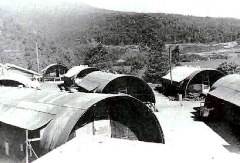 white men working as menial labourers and chauffeurs for the very first time. These were the handful of remaining WWII collaborators, who had been sentenced to heavy labour as part of their rehabilitation
white men working as menial labourers and chauffeurs for the very first time. These were the handful of remaining WWII collaborators, who had been sentenced to heavy labour as part of their rehabilitation
In those days, Hollandia was no more than a collection of old warehouses and American quonsets (semi-circular iron structures with corrugated tin roofs), some of which had been extended to be used for housing and storage, offices and shops. At that time, the Oranje Laan was the main street and most of the Dutch citizens and military staff of Hollandia lived here.
On arrival, the DETA-boys were transported with American trucks to the former barracks of KNIL officers (Royal Netherrlands east Indies Army) at Kloofkamp. They were unloaded on the village square opposite Kloofkamp Church. They received a pair of pants, a shirt and gym shoes which came straight out of the former US Navy warehouses. The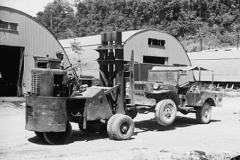 quonsets on the river banks, built on stilts, were to be their living quarters. Each barrack had its own shower and toilet facilities. The conditions were downright primitive, to say the least. Most of the DETA-boys were put to work on the Government wharf at Hollandia, known as GWH. This was situated at a spot where the Americans had their Destroyer Repair Base during the invasion. Everything that could move or sail had a maintenance check or was repaired here. At the time that the DETA-boys worked at the GWH, it was being administered by a former war convict who had decided to stay on after he had done his time.
quonsets on the river banks, built on stilts, were to be their living quarters. Each barrack had its own shower and toilet facilities. The conditions were downright primitive, to say the least. Most of the DETA-boys were put to work on the Government wharf at Hollandia, known as GWH. This was situated at a spot where the Americans had their Destroyer Repair Base during the invasion. Everything that could move or sail had a maintenance check or was repaired here. At the time that the DETA-boys worked at the GWH, it was being administered by a former war convict who had decided to stay on after he had done his time.
All kinds of machinery were to be found at this base, from bulldozers and cranes to shovels, draglines and diggers of various descriptions. Everywhere in the bush storage depots, usually overgrown by the lush vegetation of the tropics. To dismantle or repair the machinery, the DETA boys often had to construct makeshift tools before they could get down to work. At times, there was no hoisting gear or forklift to shift the equipment, delaying the necessary repairs.
6. Relaxation and entertainment
Fishing and hunting were favourite pastimes for these young men. DETA also made 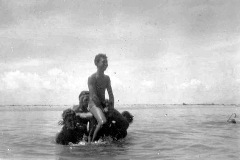 transport available on Sundays, so they could go swimming in the sea at Base G. Other than this and the Saturday night movies, there was very little entertainment to be had. Boredom occasionally led to fights between DETA-boys on the one side, and Marines stationed in Hollandia as well as crew members from other boats, on the other. One legendary fight between DETA-boys and marines of the ship ‘Hr.Ms.Kortenaer’ occurred on 31 August 1950 in front of Slockers’ House, a social hall along the coast near the Berg and Dal Area.
transport available on Sundays, so they could go swimming in the sea at Base G. Other than this and the Saturday night movies, there was very little entertainment to be had. Boredom occasionally led to fights between DETA-boys on the one side, and Marines stationed in Hollandia as well as crew members from other boats, on the other. One legendary fight between DETA-boys and marines of the ship ‘Hr.Ms.Kortenaer’ occurred on 31 August 1950 in front of Slockers’ House, a social hall along the coast near the Berg and Dal Area.
Hollandia Film House provided the DETA-boys with a clip card that allowed them to view four films for just one guilder. Consequently, the boys used to spend their social life near the cinema, situated near the Post Office and the Cashier's Office. However, halfway 1950 a number of the DETA-boys moved to the Oranje Laan, to an old American shed which had been clad with plywood to make it habitable. Mid-1951, the other boys still at Kloofkamp, also shifted here and to ‘Bonte Dorp’, a small terraced village constructed by the Americans when they were there during the war. This move meant that they were less isolated than before
Meanwhile, the DETA-boys were being employed to build dozens of homes for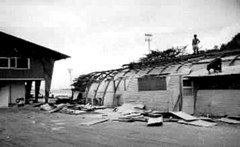 administrative staff and to construct roads and bridges. They also helped to unload ships and often worked overtime till 10 pm at night. The ones that were not on duty used to stay home, get out their guitars and have sing-along-sessions.
administrative staff and to construct roads and bridges. They also helped to unload ships and often worked overtime till 10 pm at night. The ones that were not on duty used to stay home, get out their guitars and have sing-along-sessions.
The DETA-boys also built a pier for the Nederlandse New Guinea Petroleum Maatschappij( NNGPM, a Dutch oil company) , as well as an L-shaped cantine for the company workers using recycled quonset material. This pier and the building were later confiscated by the Dutch Government and it became a marina and yacht club for the well-to-do of Hollandia.
7. DETA-boys on Biak Island
A team of Deta-boys was also sent to Biak from the middle of June till the middle 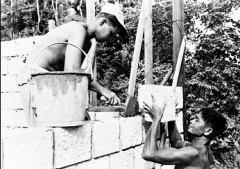 of August 1951. This team had been responsible for building the residence of Mr Lammers, the then adminisrator of Hollandia. On Biak, this team became responsible for renovating the KLM personnel quarters near the only international airport in existence on New Guinea. Everything had to be renewed. Materials such as hardboard, battens , lavatory pans, faucets and new paint came from Hollandia, but lumber, plywood, water supply pipes and fittings came from the American dumps. Apart from the usual carpentry, masonry and plumbing tools, the team had also taken along special gear for the plumber to improve the water reservoir. This was a centrifugal pump and a gasoline engine to pump fresh water from a small underground cave to a reservoir abandoned by the Americans in WW II.
of August 1951. This team had been responsible for building the residence of Mr Lammers, the then adminisrator of Hollandia. On Biak, this team became responsible for renovating the KLM personnel quarters near the only international airport in existence on New Guinea. Everything had to be renewed. Materials such as hardboard, battens , lavatory pans, faucets and new paint came from Hollandia, but lumber, plywood, water supply pipes and fittings came from the American dumps. Apart from the usual carpentry, masonry and plumbing tools, the team had also taken along special gear for the plumber to improve the water reservoir. This was a centrifugal pump and a gasoline engine to pump fresh water from a small underground cave to a reservoir abandoned by the Americans in WW II.
The meals for the men were prepared by two Papua cooks. Occasionally, the DETA-workers had some fresh fish which the cooks caught in their spare time, but other than that they mainly lived on tinned food. Coffee and tea were not popular due to brackish water and they quenched their thirst with Heineken beer and fresh rain water when this was available.
The conditions at the airport were fairly basic in those days. If a Skymaster or Constellation landed on Biak, the KLM staff lit a fire on the side of the landing strip. The direction of the smoke indicated how the plane was to land. There were no busses for the arriving passengers. They were transported by wagons hooked onto a large tractor.
The team of DETA-boys returned to Hollandia after the two months it took them to complete renovations.
8. Deta workers found their own way
After the DETA-boys had completed the contract, they went on theirway. They could either stay or leave to try their luck elsewhere.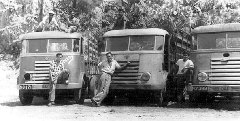 Many of them actually volunteered for the Korean War as a means of saving the money needed to go to the Netherlands. However, only a handful were selected. Of the 1000 that came originally, only 35 returned to Indonesia and a few dozen went to the Netherlands. The majority had to stay in Hollandia due lack of finance. They simply could not afford to pay for the journey to the Netherlands. A few of them set up their own building company, others specialized in masonry and tiling, or worked on building sites making the forms for pouring concrete foundations. A number of them also went to work on sawmills and farms or became taxi drivers. By now the DETA-boys had built up a reputation for hard work and the days that they would work for next to nothing, were well gone.
Many of them actually volunteered for the Korean War as a means of saving the money needed to go to the Netherlands. However, only a handful were selected. Of the 1000 that came originally, only 35 returned to Indonesia and a few dozen went to the Netherlands. The majority had to stay in Hollandia due lack of finance. They simply could not afford to pay for the journey to the Netherlands. A few of them set up their own building company, others specialized in masonry and tiling, or worked on building sites making the forms for pouring concrete foundations. A number of them also went to work on sawmills and farms or became taxi drivers. By now the DETA-boys had built up a reputation for hard work and the days that they would work for next to nothing, were well gone.
Half way through the fifties with the development of New Guinea well on the way, there was plenty of employment for the men. However, the ideal of an Indo-European homeland was not realised as the focus had shifted to developing the Papuan population. The DETA-men therefore chose to focus on the work they were interested in at a wage they determined themselves. Five years after their arrival, their financial situation was much improved, judging by the way they tore around on motorbikes, the most sensible and also affordable form of transport on the poor roads of Hollandia. Having their own form of transport meant that they did not need to be dependent on the Government Auto-Bus Service, and they could tour around with their girlfriend if they had one. 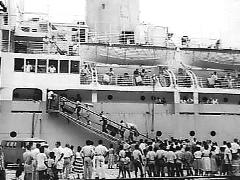 The bond that developed between the men remained close even after they came to the Netherlands in the early sixties, when the handover of New Guinea became apparent under the threat of war and the entire Dutch community of about 15.000 people was evacuated. In August 1962, the Dutch flag was lowered for the last time. The DETA-men were in the Netherlands by then. Since 2000 the DETA-boys organise regular reunions and they have started to call these “Kroonduif Reunions”.
The bond that developed between the men remained close even after they came to the Netherlands in the early sixties, when the handover of New Guinea became apparent under the threat of war and the entire Dutch community of about 15.000 people was evacuated. In August 1962, the Dutch flag was lowered for the last time. The DETA-men were in the Netherlands by then. Since 2000 the DETA-boys organise regular reunions and they have started to call these “Kroonduif Reunions”.
9. Links
- van Eechoud, JPK (ex-governor of former Dutch New Guinea). Nota about DETA, (pdf),14 September 1950.
- Meijer, Hans. 'Daar heb je ze weer' (pdf ), May 2007.
- Background stories on DETA-workers, blog.londoh.com. (Accessed April 2010)
- Jayapura Centenary in 2010. Theme page on PACE website.
10. Sources
- Balgooy, N.A.van, Tomasouw, R.A. and Snackey, FA. DETA-contractanten : gedenkboek ter gelegenheid van ons 12-jarig verblijf in Nieuw Guinea 1950-1962. (ISBN 90-804635-1-5).
–Doel, H.W. van den. 2000. Afscheid van Indië. De val van het Nederlandse imperium in Azië. Amsterdam: Prometheus
–Doorn, J.A.A. van. 1995. Indische lessen. Nederland en de koloniale ervaring. Amsterdam: Bert Bakker
- Kambek, Neffer & Schoonenberg. 2005. Indische Nederlanders in roerige tijden, Amsterdam : KIT Publishers.(ISBN 9789068321784)
– Lijphart, Arend. 1966. The trauma of decolonization; the Dutch and West New Guinea New Haven. Yale University Press
–Meijer, Hans.1994. Den Haag-Djakarta. De Nederlands-Indonesische betrekkingen 1950-1960 . Utrecht: Het Spectrum
–Meijer, Hans. 1997. ‘Bestemming Nieuw-Guinea. De lotgevallen van de opvarenden van de ms Waibalong’. In Uit Indië geboren. Vier eeuwen Indische familiegeschiedenis, by WimWillems et.al. , 150-165. Zwolle : Waanders
–Meijer, Hans. 1998. ‘Door Ellende tot Armoede. De DETA-jongens als kwartiermakers op Nieuw-Guinea’. In Tijdschrift voor Sociale Geschiedenis 24, 4, 345-370.
- Meijer, Hans, ‘Het uitverkoren land. De lotgevallen van de Indo-Europese kolonisten op Nieuw-Guinea (1949-1962)’ in Tijdschrift voor Geschiedenis 112 (1999) 3, 353-384
–Meijer, Hans. 2004. In Indië geworteld. De twintigste eeuw. Amsterdam:Bert Bakker
- Meiracker, Kees van den. 1998 ‘Nederlands-Nieuw-Guinea na de overdracht’ in Spiegel Historiael, 23, 7/8.
–Willems, Wim. 2001. De uittocht uit Indië 1945-1995. Amsterdam: Bert Bakker
– Advice and comments: Dr. Hans Meijer, Author and University lecturer at the State University of Groningen, the Netherlands.
He is a specialist in the field of (post )- colonial relations between the Netherlands and Indonesia.